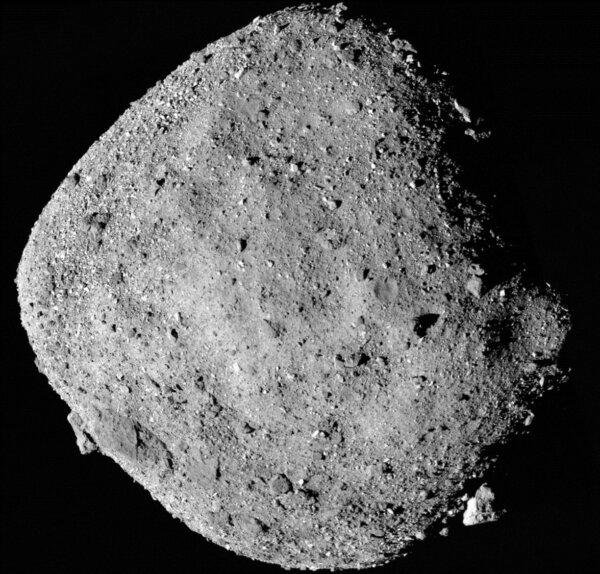Life’s Building Blocks Discovered in Samples from Asteroid Bennu
WASHINGTON—NASA has reported that rock and dust samples collected from the asteroid Bennu contain some of the essential chemical building blocks of life. This finding offers compelling evidence that such celestial objects may have contributed to the early Earth’s environment, supplying the fundamental ingredients necessary for the emergence of life.
The U.S. space agency’s OSIRIS-REx spacecraft gathered these samples in 2020 from Bennu, a near-Earth asteroid that is a remnant of a larger body formed around 4.5 billion years ago during the early solar system’s development. The samples were safely returned to Earth in 2023, parachuting down in a capsule released from OSIRIS-REx, which landed in the Utah desert.
Two studies analyzing the samples were published on Wednesday.
One study, featured in the journal Nature Astronomy, identified a variety of organic compounds within the samples. The other, published in the journal Nature, discovered minerals that formed when brine—salty water—evaporated on Bennu’s parent body. Such environments are thought to support prebiotic organic chemistry.
The samples revealed the presence of 14 out of the 20 amino acids utilized to create proteins—complex molecules that are crucial for the structure, functionality, and regulation of living organisms. Additionally, all five nucleobases, which are the key components of DNA and RNA found in all forms of life on Earth, were also detected.
During the early solar system, planets like Earth, along with various moons, experienced bombardment by asteroids and other debris laden with water and organic compounds.
Astrobiologist Danny Glavin from NASA’s Goddard Space Flight Center in Maryland, and lead author of one of the studies, stated, “The identification of these vital building blocks of life in the Bennu samples bolsters the hypothesis that asteroids and their fragments provided the early Earth with primary materials that facilitated the development of life.”
“Additionally, the discovery that these chemical precursors to life can originate in space and are prevalent throughout the solar system enhances the likelihood that life might have begun beyond our planet,” Glavin emphasized.

This mosaic image of asteroid Bennu was created using 12 PolyCam images taken by the OSIRIS-REx spacecraft from a distance of 15 miles on Dec. 2, 2018. NASA/Goddard/University of Arizona/Handout via Reuters
Organic compounds consist of one or more carbon atoms bonded to various other elements, typically hydrogen, oxygen, nitrogen, and sulfur. All life on Earth is carbon-based and is composed of organic molecules, such as the amino acids that form proteins and nucleobases.
A nucleobase is a nitrogen-containing compound integral to the storage of genetic information. DNA (deoxyribonucleic acid) and RNA (ribonucleic acid) are biomolecular relatives that serve as fundamental components of cell biology. DNA encodes an organism’s genetic information, while RNA transmits and implements this information.
“All biological entities are formed from organic compounds. The origin of life is intertwined with organic chemistry, some of which can be traced back to these 4.5 billion-year-old rocks,” remarked astrobiologist and study co-author Jason Dworkin, the OSIRIS-REx project scientist.
The organic compounds from Bennu have previously been detected in meteorites that have landed on Earth, but concerns remained about potential contamination from terrestrial sources. In contrast, the Bennu samples were collected directly from the asteroid, ensuring their pristine quality.
“We can have confidence in these findings,” Glavin affirmed.
Bennu’s icy parent body, estimated to be about 60 miles in diameter, seems to have originated in the outer solar system and may have been destroyed about 1-2 billion years ago. The resulting fragments formed Bennu and other “rubble pile” asteroids—aggregations of rocky material rather than solid bodies.
At some point in its past, it appears that some ice within the parent body melted, generating brine. The minerals resulting from the evaporation of this brine had not been detected in meteorites that landed on Earth previously.
“The brine created a setting where elements and simple organics could unite to form more complex prebiotic organics essential for life,” explained geologist Tim McCoy, lead author of one study and curator of meteorites at the Smithsonian Institution’s National Museum of Natural History in Washington.
However, researchers did not identify actual DNA or RNA within the samples.
“The collection of simple protein amino acids and nucleobases found in Bennu is a long way from anything akin to ‘living’ systems, such as a self-sustaining chemical mechanism capable of replication and evolution, which is comprised of much larger polymers like proteins and nucleic acids found within cells,” Glavin stated.
By Will Dunham





